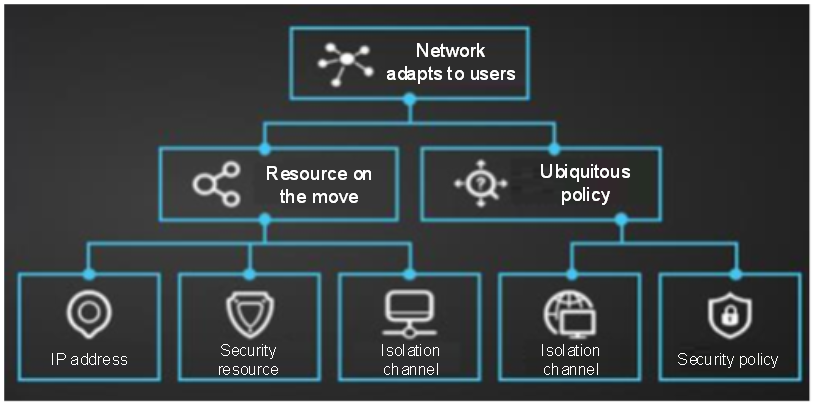H3C Smart Campus Solution
1. Demands
The campus Wi-Fi network mainly provides network services for all personnel on the campus. It must cover all sites and provide a wireless network environment so that campus personnel can efficiently use the network anytime and anywhere. It enhances the network environment, improves the management level and efficiency, and promotes information construction.
The core demands of the current campus network are as follows:
Network stability and reliability:
The campus network must be stable to prevent lags, dropouts, weak signals, and other problems with wireless networks. Users can access the Internet with high speed and stability when they use intelligent terminals such as laptops, PDAs, and cell phones that support Wi-Fi access to the WLAN. This enables campus personnel to access the Internet and search for information anytime and anywhere.
Reliability is the overall demand for the entire campus network. It requires the network to have redundant disaster recovery functions to prevent the overall network from being unavailable due to the device failure.
Simple management:
The network supports simple management and easy network configuration and adjustment. This ensures the network works in a good state and can quickly restore services when a failure occurs.
Network security:
The network supports flexible and secure access authentication methods for different scenarios, and provides different levels of security protection for employees, users, and devices that request access. Only authorized users can access the network and perform operations in the mobile office applications such as browsing, approving, and sending and receiving emails through the LAN.
Multiple wireless security protection methods are supported to prevent common wireless network security threats, such as phishing AP.
IoT expansion:
The network combines with IoT technology to manage the entire campus environment and the actual energy consumption to realize smart campus control.
2. Wireless design of H3C smart campus solution
H3C smart campus solution adopts a three-layer network architecture, which is divided into the access layer, convergence layer, and core layer, to ensure the network quality and fairly carry the network traffic. To eliminate network bottlenecks, the access layer provides gigabit access downlink and 10 gigabit access uplink to the convergence layer.
Wireless network: Adopt a scenario-based design and provide specific coverage solutions based on the campus type with no signal blind areas; provide specific coverage solutions for high concurrency areas with no network lag; provide VIP assurance for important terminals and areas with guaranteed services.
Access layer: Ensure gigabit links to terminals and 10 gigabit links to the convergence layer. All switches in the access layer support PoE power supply to provide remote power supply for APs.
Convergence layer: Support 10 gigabit interconnection and Intelligent Resilient Framework of the Second Generation (IRF2) technology, allowing multiple physical devices to be interconnected and virtualized as a logical device. In this way, users can manage and use these multiple devices as a single device, simplifying management and improving the device reliability in the access layer.
Core layer: The core switches adopt the virtual deployment of dual switches. Two core switches are virtualized into one logical device using the mature and advanced horizontal virtualization technology. The two core switches can simultaneously forward services and back up each other. This provides the entire extranet system with a high-performance and highly reliable core forwarding platform.
Security design: To prevent network attacks and ensure network security, multiple security devices are deployed to achieve comprehensive security protection and ensure data security compliance on the campus.
O&M design: Support the integrated maintenance of wired and wireless networks, graphical interface, integration of intelligent O&M, intelligent fault location, and automatic alarm of danger.
3. Advantages
Convenient O&M and simple deployment
Network deployment: Support automatic deployment to achieve fast deployment and greatly improve the launch efficiency.
Service deployment: Provide a graphical configuration interface and reduce the deployment difficulties based on user- and role-based configuration.
Network O&M: Incorporate automatic AI O&M capabilities and support rapid fault location and one-click network optimization by default.

Finer control capability
Realize the separation of the physical network and virtual service network. The virtual network is unaffected by physical location changes. When the physical location of a service or user changes, the corresponding resources (such as IP address, security resource, and isolation channel) and policies (such as network policy and security policy) change dynamically. This achieves zero administrator intervention and greatly improves the efficiency of O&M management.

Smoother network experience
Realize full and refined coverage of wireless networks on the campus with scenario-based professional AP deployment. APs adopt the next-generation wireless protocols, support multiple radio frequencies and priority access to the 5G band, and easily cope with high-density access. A variety of intelligent optimization technologies bring better Internet experience and fully adapt to application scenarios of smart campus!
Integration of IoT expansion to create a smart campus
Use information and communication technologies to sense, analyze, and integrate various key information of the campus. In this way, smart responses can be made to various demands on the campus including manhole covers, garbage bins, environment monitoring, temperature and humidity monitoring, lighting, and electricity meters, to realize smart campus management and operation and create the concept of a green campus.


